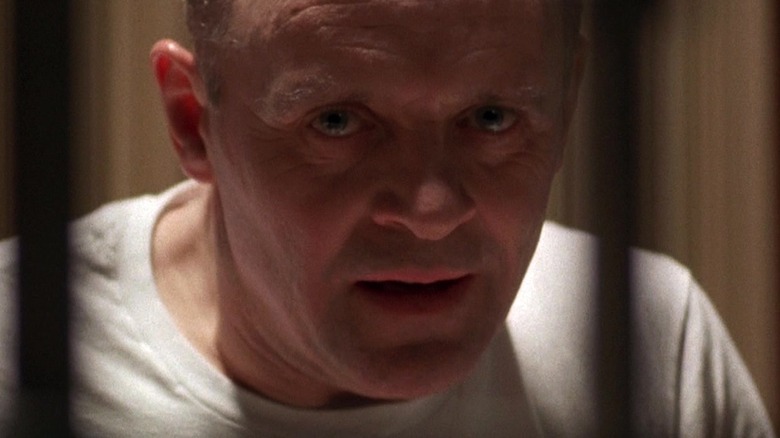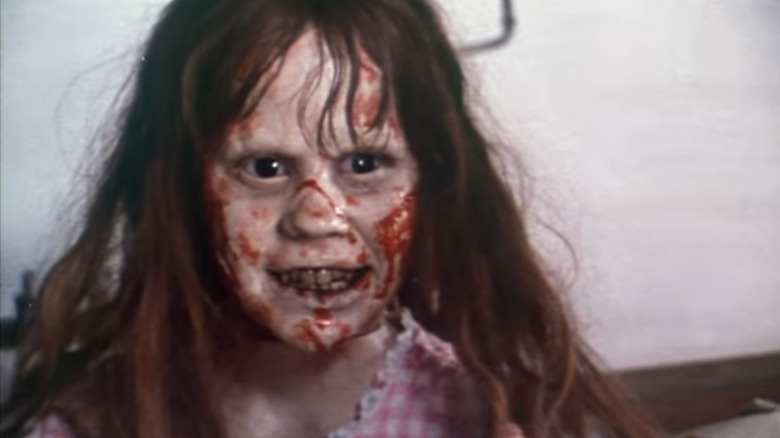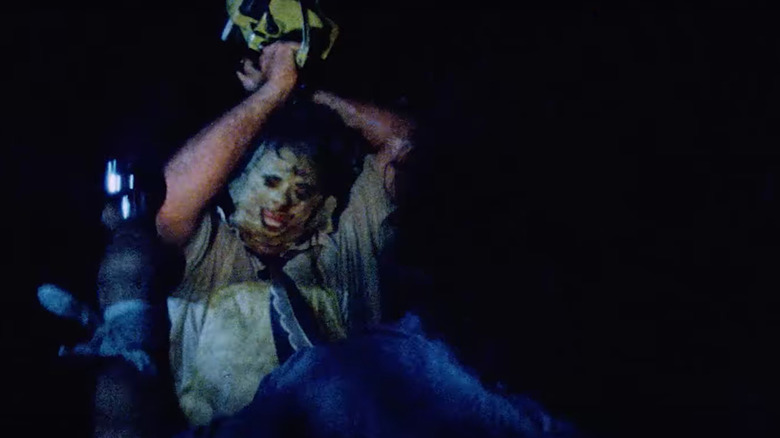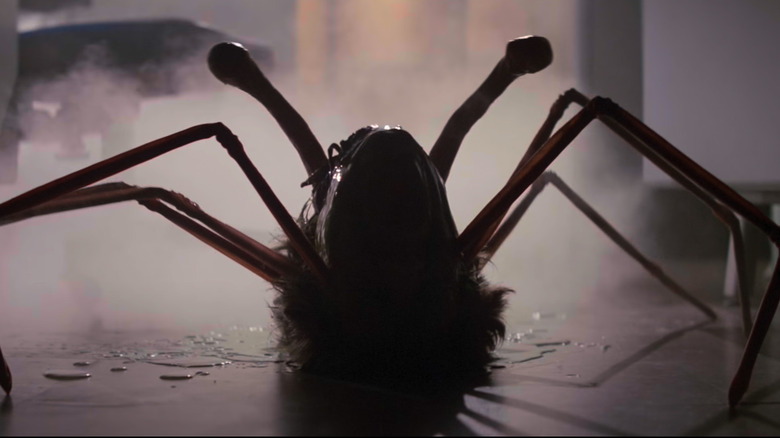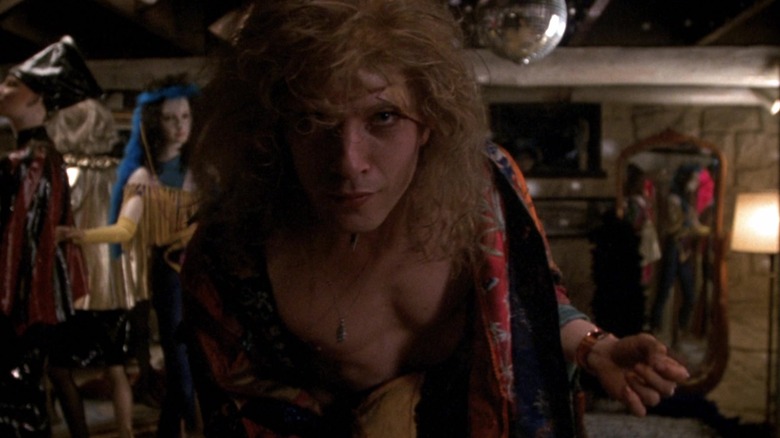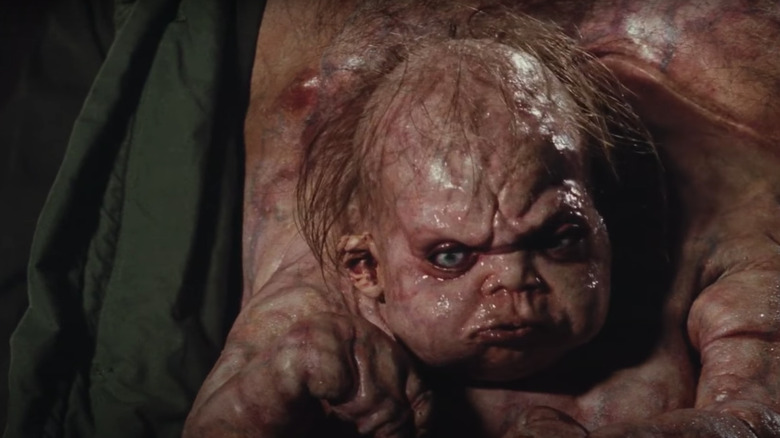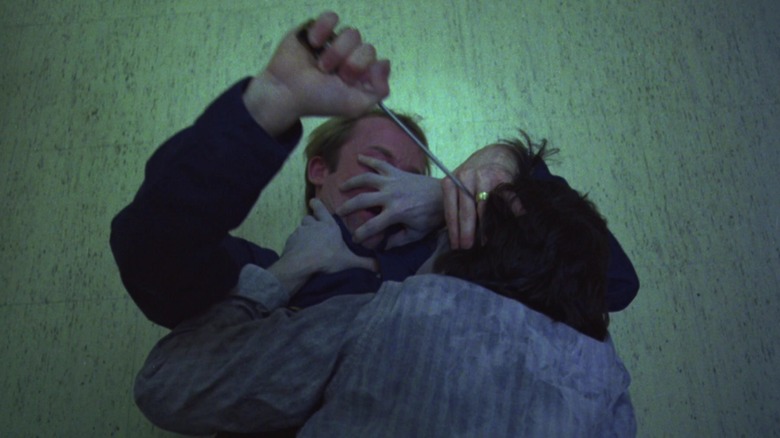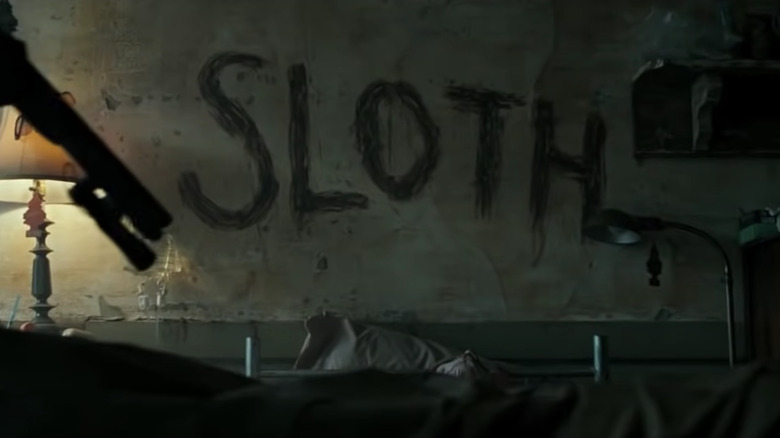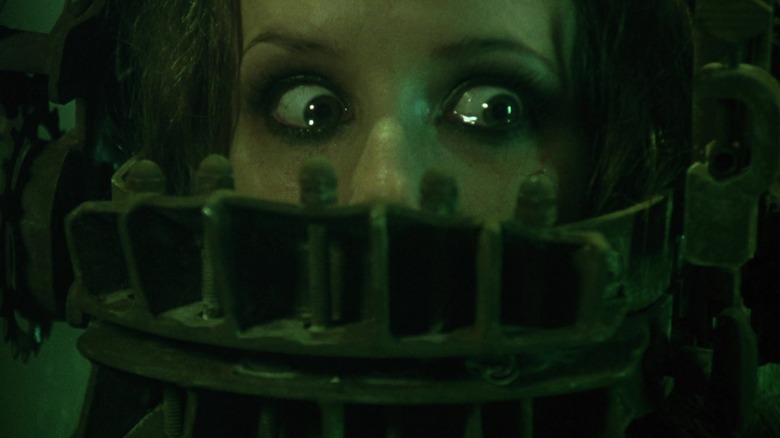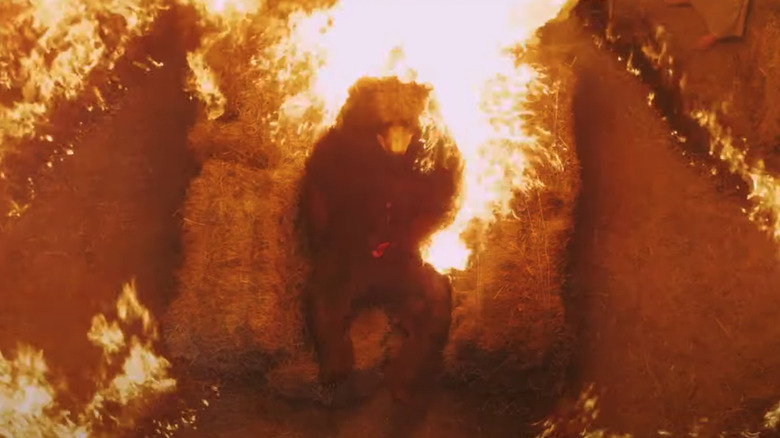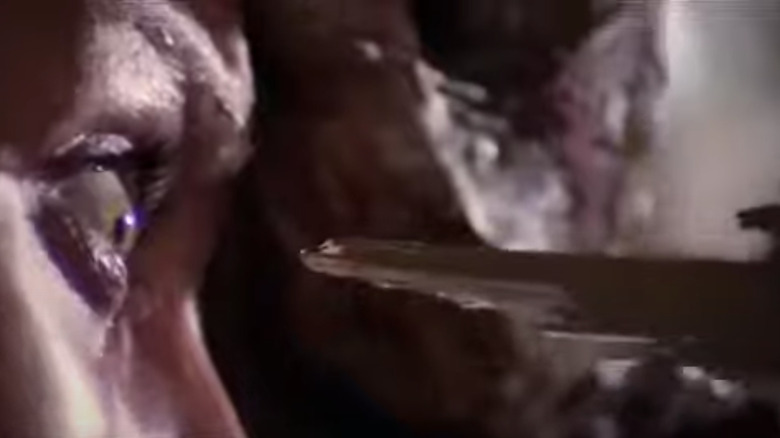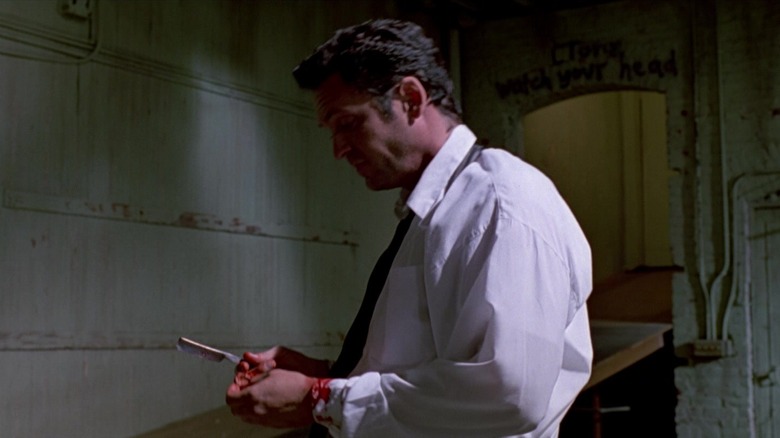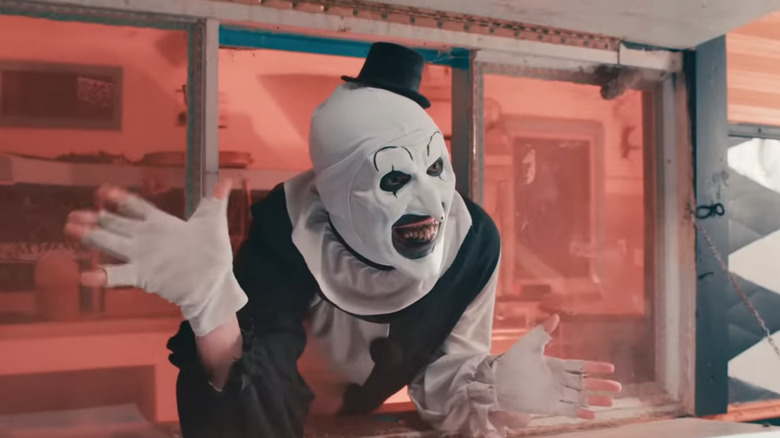The Most Controversial Movie Props Explained
Certain films can sear moments into your brain — maybe with a great shot, an incredible line of dialogue, or a particular bit of production design. Indiana Jones (Harrison Ford) wouldn't be the same without his iconic whip and hat, after all, and horror films and thrillers also lean heavily on the prop department to create memorable (often visceral and disgusting) moments. In the best films that disturb you and create nightmare fuel, there are elements and segments we simply can never forget.
Many horror-thriller films come with their share of controversy; even the latest horror sensation, the "Terrifier" series, has freaked people out over its sick gore set pieces (via USA Today). There have been a number of effects and props that have proven themselves to be every bit as controversial and unforgettable as the films they're a part of. Most cinephiles would agree that Leatherface's chainsaw or Jason's machete belong in the same movie prop pantheon as the lightsaber or the DeLorean.
Many props have also played a part in stoking controversy among critics and audiences. These bits of horror-thriller prod design are disturbing, extreme, or heavily symbolic. But for one reason or another, they became part of movie mythos, continuing to inspire controversy in the years since their release. Here are the most controversial movie props, explained.
The Exorcist dummy
When "The Exorcist" was released in 1973, audiences completely freaked out, and it's still a strong and powerful experience to see it today. There are a number of legendary and controversial segments in "The Exorcist" that made audiences terrified and queasy, and modern audiences still freak out when Linda Blair's head spins around.
To achieve the impossible supernatural effects of "The Exorcist," makeup maestro Dick Smith created a life-size dummy of Blair to do the head-spinning. The dummy could sit up, move its eyes, emit fog from its mouth like someone breathing in cold air, and of course, spin its head 360 degrees. To get this done, Smith said in the "Exorcist" documentary, "Fear of God," "The only way to do it was to make a dummy and have a mechanical head. [...] The head and the torso are rigid plastic because the head had to rotate smoothly." The dummy's hair also conveniently covered up the separation between the head and the body. A remote control allowed them to
As a joke, they took the dummy in the front seat of a taxi, to see how drivers would react, which must have been quite a sight. Smith recalled, "The head would wobble around so it would look like it was alive."
The Leatherface mask
Horror franchise characters are often known for their terrifying masks, and Leatherface (Gunnar Hansen) from "The Texas Chain Saw Massacre" had three different masks made of human skin, each representing a different mood. Of course, the masks were actually made of latex and fiberglass, but his look was very unsettling, and it became an important trademark of the franchise. Make-up artist Robert A. Burns created the Leatherface masks, and as Ransom Center Magazine explains, "Burns used layers of latex rubber, mixing in a brown fiberglass insulation material into the liquid latex, and casting the mixture into molds taken from the faces of friends." The inspiration for Leatherface wearing human skin masks was loosely based on Ed Gein, the Wisconsin madman who wore the body parts of his victims and also made furniture out of severed limbs. (Norman Bates in "Psycho" was loosely based on Gein as well.)
Though little gore is actually shown in the film, "The Texas Chain Saw Massacre" earned revulsion upon its release, with the film actually being pulled from cinemas in Canada (via the Ottowa Citizen). Overseas, it was also rejected by the British Board of Film Classification for its graphic content. Though director Tobe Hooper probably hoped for a less harsh response to the film, that its chainsaw-wielding psycho killer also wears a mask made of human skin probably had something to do with the backlash.
The Thing spider head
"You gotta be f***in' kidding." You probably remember that line from John Carpenter's "The Thing," when a head grows spider legs and starts scurrying across the floor. "The Thing" was a practical effects tour de force, with makeup artist Rob Bottin creating an incredible new standard that still holds up well today. During its initial release, "The Thing" was a controversial movie because it was too repulsive for audiences and critics to take at the time — Roger Ebert gave it two and a half stars, dismissing it as a mere "gross-out" movie, and the film flopped financially (via The Take).
It's since grown into a revered cult classic, and fans who are sick of CGI are amazed by what Bottin and Carpenter could pull off live on set. (Bottin was also 22 years old when he pulled off all this incredible work.) With "The Thing," Bottin let his imagination run wild, and the spider head stands as one of the most memorable creatures in the film. It's also remarkable to note how much Bottin was able to pull off considering the technology that was available at the time, but he did a lot with latex, remote control, robotics, and more. The head itself was completely practical (per Screen Rant). In close-up shots, a mechanical head was used, while in long shots, a remote control allowed it to skitter across the floor. It's absolutely one of the best effects in horror history — although if you love dogs and hate spiders, we highly recommend you avoid this movie.
The Silence of the Lambs skin costumes
For a five-time Academy Award winner, Jonathan Demme's "The Silence of the Lambs" is a gory film. Hannibal Lecter's (Anthony Hopkins) escape sequence provides two of the film's biggest gross-out moments: The reveals of the disemboweled corpse of Lt. Boyle (Charles Napier) and the bloodied Sgt. Pembry (Alex Coleman) rank among the sickest moments in horror history.
But the bloody violence isn't what drew controversy in "The Silence of the Lambs." That would be the character of Buffalo Bill (Ted Levine), whom many LGBTQ rights advocacy organizations decried at the time as being a negative queer stereotype and also a psychotic killer. Now, "The Silence of the Lambs" has been connected to negative representations of transgender identity in film, as Buffalo Bill dresses in women's clothes and wears the skin of his female victims (per Vox).
Among Buffalo Bill's more frightening possessions are a woman's scalp, which Clarice Starling (Jodie Foster) finds shortly before he turns the lights out in the basement, and skin that the killer has hanging around his home. The film's production designer, Kristi Zea, drew inspiration from the dark paintings of Francis Bacon to create the eerie atmosphere (per Vanity Fair). But even Buffalo Bill's lair was too much for her — "It gave me the creeps," Zea said. "I said, 'Really? You're going to make a movie about a guy who skins women and makes outfits out of them? Jonathan, what are you doing? Are you crazy?'"
Kuato and the three-breasted woman from Total Recall
Rob Bottin created many iconic visual effects of the 1980s and '90s, and two of his craziest creations include Kuato and the three-breasted woman from "Total Recall." Kuato is a creature similar to Yoda, but where Frank Oz's puppet can look, dare we say, cute, Kuato looks like a sweaty hundred-year-old baby. Marshall Bell, who had Kuato growing out of him, called Bottin, "The Leonardo da Vinci of prosthetics people." (Bell also spent nine hours in the makeup chair for Kuato).
Another bizarre prosthetic in "Total Recall" was the sex worker with three breasts, a character who returned for the remake, and she displayed her unusual chest to help promote the film at Comic-Con (via the Daily Mail). As for how much of the character was prosthetic, Lycia Naff, who played the original character, recalled that she spent five and a half to eight hours in the makeup chair (via The Palm Beach Post). "It's actually a gigantic, amazing breastplate designed by Rick Baker, the famous, famous special-effects makeup guy," she said. "It takes hours and hours of makeup to blend this chest piece to your actual skin. Every day would be a fresh one. The day that I got shot and killed, they had to replace it a couple of times because it burst open with blood capsules that exploded by remote control." She added that she only took the job for the money and was pretty embarrassed by her role, transitioning to journalism soon after.
Dawn of the Dead's zombie kill effects
The original "Dawn of the Dead," released in 1979, was a truly epic horror film. It was a great showcase for the makeup effects mastery of Tom Savini, who did some of the best gore effects in the genre, including the original "Friday the 13th," "Creepshow," and "Day of the Dead." "Dawn of the Dead" had many hideous gore set pieces, and it was released unrated because of its violence. Some filmgoers and critics couldn't take it — some even walked out of the film. George A. Romero's movie earned a lot of controversy because it was released unrated (via IGN). Unwilling to cut out many of the goriest effects, this was the only way Romero thought he would make money back on the project — otherwise, he was facing an X rating.
Savini's genius effects in "Dawn of the Dead" inspired many slashers and zombie films to come, as the characters made good use of knives, shotguns, and machetes to dispatch the living and the undead. One famous effect finds survivor Roger (Scott Reiniger) stabbing a zombie through the ear with a screwdriver — one of the most creative and bloody kills in the film. When he was first hired on the film, Savini went to Pittsburgh to shoot, and he pitched the screwdriver-in-the-ear gag to Romero. The director loved the idea, so Savini set to work making retractable screwdrivers (via the Pittsburgh City Paper). The kill was so iconic that "The Walking Dead" later paid homage to it in Season 2, with Andrea (Laurie Holden) dispatching a walker by sticking a screwdriver into its eye.
The seen and unseen in Seven
Like "The Texas Chain Saw Massacre," David Fincher's "Seven" doesn't show as much as you think it does. But the macabre detective thriller certainly shows enough to make your skin crawl. There's only one murder on screen in "Seven," when John Doe (Kevin Spacey) is shot by Detective David Mills (Brad Pitt) — as for the rest of this horror show, Fincher only shows the aftermath of Doe's killings. However, that doesn't change the fact that the "gluttony" and "sloth" bodies found by Mills and his partner (Morgan Freeman) are some of the most hideous movie moments ever committed to film. The gluttony corpse gives new meaning to the term "morbidly obese," and with the sloth killing, the body is so emaciated that you assume he's dead until he starts coughing.
The makeup effects for "Seven" were created by Rob Bottin, who worked on "The Thing" and "Total Recall." Both bodies are great pieces of makeup work. While Bottin could have come up with something horrible for the "lust" murder, it's thankfully never shown; as for the most controversial killing, the infamous head in the box segment in the climax, Fincher smartly never shows that, either. Fans nevertheless continue to discuss the film's most morbid scenes. On Reddit's r/movies forum, u/gangaqueen20 sparked a debate about what's the most brutal killing in the film, while on the subreddit r/TrueFilm, users debated the film's ending — whether Mills makes the right call, whether John Doe "wins" in the end, and what is, ultimately, in the box.
The reverse bear trap in Saw
One of the most disturbing devices in horror is the reverse bear trap from "Saw," and it made a powerfully disturbing image in promoting the film — maybe too disturbing for some audiences. The "Saw" series was created by Leigh Whannell and James Wan, and no sooner did the first film debut than critics nationally decried its intense violence, gruesome torture, and appalling set pieces (per The Guardian).
Of all the torturous props in the first film, from the hacksaw to a collection of barbed wire, the reverse bear trap was perhaps the hardest to work with. As the film's special effects supervisor explained (per ScreenRant), "The problems with it were it was so heavy and so mechanical, and so we had to come up with something else." They then created a new bear trap made out of aluminum that was made to look like rusty metal. The device was inspired by medieval torture devices, and when Whannell did some research, he was shocked at how sick some of these devices were, especially during the Inquisition era.
The Midsommar bear suit
In "Midsommar," one of the victims of the Swedish cult is Christian (Jack Reynor), who is sewn into a bear suit and burned to hopefully purge the cult's sins. The bear suit and the character's death are some of the most iconic elements of Ari Aster's folk horror film, and there have been a number of theories as to what his death represents. One Reddit thread, from u/1877carsforkids, wondered, "What does the Bear symbolize? Beastly nature? Hidden aggression? Protection?" Across Reddit in various forum posts, fans of the film debated the meaning of the film's final, shocking death, including whether or not Christian had it coming.
Finally, Aster addressed the controversy, but he didn't clear it up much. As he told MovieWeb, "The bear is a very important symbol in Norse mythology and in Scandinavian folklore. It was loaded in all of the right ways. To sort of tie it to Christian and the way that he dies. It occurred to me at some point in doing research for the film that this is the right way to send Christian off." So I guess it's up to the audience to figure out what Christian's death — and the unlucky bear that's a part of it — are meant to symbolize.
The splintered eyeball in Zombie
Lucio Fulci, one of the most notorious horror directors in history, came up with an eyeball gag in his 1979 Italian film "Zombie" — aka "Zombi 2" or "Zombie Flesh Eaters" — that became one of the most notorious killings in the film. One of the undead grabs a woman's head and slowly drags her up to a gigantic splinter, which pierces her eye.
Bloody Disgusting and Empire singled out this scene as the worst, most graphic in the film. Critics pinpointed the eye scene as what led to its censorship in the UK under "video nasty" laws. In fact, in the UK, the eye scene was edited for release, so audiences never got to see the eyeball punctured and the money shot, which critic Kim Newman said is like watching a "ketchup-filled plastic novelty eye [getting] gored." The excruciating scene, the tension of the splinter, and the overall grotesque gore of "Zombie" led to it being considered one of the more messed-up Italian horrors of its time.
The severed ear from Reservoir Dogs
Once you've seen the torture scene in Quentin Tarantino's debut feature, "Reservoir Dogs," you'll never hear the Stealers Wheel song "Stuck in the Middle with You" quite the same way again. In the controversial scene, Mr. Blonde (Michael Madsen) dances in front of his police officer hostage, Nash (Kirk Baltz), before cutting the poor guy's ear off and trying to set him on fire.
The scene nearly didn't make it into the final cut of the film. On "The Joe Rogan Experience," Tarantino said that infamous Miramax producer Harvey Weinstein tried to talk him into removing the torture scene. "His reasoning was, 'Look, Quentin: This is a movie that anybody can watch. But with that torture scene, you're gonna alienate women. They're not gonna wanna see this,'" Tarantino said. The famed writer-director admitted that the scene also led to walkouts when it played at film festivals, but he stood his ground against Weinstein and kept the scene in the film.
As tough as it is to watch Mr. Blonde use a straight razor to carve off a man's ear, talk into it, and then nonchalantly throw it away, Tarantino only upped the ante throughout his career. From the overdose scene in "Pulp Fiction" to the bloody climax of "Once Upon a Time in Hollywood," Tarantino is a filmmaker who delights in pushing the envelope in terms of blood, gore, and taste. At least we don't actually see Madsen cut an ear off.
The knife to the crotch in Terrifier 2
It's bad enough to get a splinter in your eye or lose your ear to a madman, but try to imagine an evil clown cutting off your member. That's one of the sickest scenes in the latest "Terrifier" film, which has reportedly been making some theatergoers physically sick (via No Film School). Filmmaker Damien Leone told Variety that this response was always what the "Terrifier" films and the character of Art the Clown (David Howard Thornton) was about — "What's gonna get people talking once they leave our movie," he said. "We can show things they would never show in a Hollywood slasher."
However, even compared to the gory glory days of mad slasher movies, the "Terrifier" films have some gross-out effects and hard-to-watch sequences, including a scene in which Art castrates a man with a knife. We never see a penis on-screen, but the amount of blood and entrails in "Terrifier 2" is enough to make you sick anyway. For Leone, who wrote and directed the series and also supplied the film's sick gore effects, that scene was where he drew the line. If you ask the audiences who passed out, vomited, or left the theater during the film, Leone's standards are still a little too gory for some.
